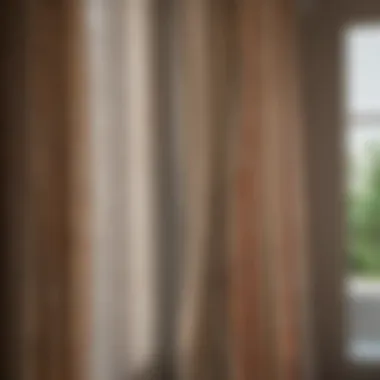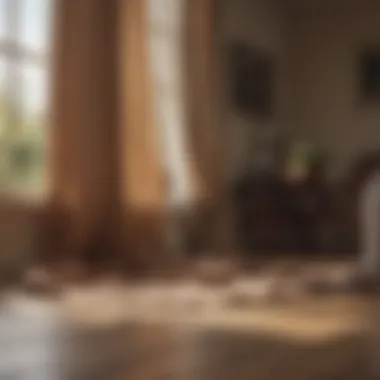A Comprehensive Guide to Cleaning Cloth Window Shades


Intro
Cleaning cloth window shades is a task that, while often overlooked, plays a crucial role in maintaining the overall aesthetic and functionality of your home. Many homeowners and design lovers may not realize that these shades can harbor dust, allergens, and stubborn stains. This guide delves into effective cleaning methods tailored to various materials and stain types. Additionally, it highlights preventative maintenance strategies that can prolong the lifespan of your window coverings.
Understanding the types of cloth shades is essential before embarking on their maintenance. Each variety—such as roller shades, roman shades, or sheer fabric curtains—has unique properties that determine suitable cleaning techniques.
The goal is not only to clean but also to enhance the visual appeal of your living space, ensuring your window coverings remain a proud feature of your home.
By acquiring knowledge from this article, readers will be better equipped with practical advice that caters to both the aesthetic and functional aspects of their window shades.
Understanding Cloth Window Shades
Cloth window shades are more than just functional items; they serve as a vital component of interior design. Understanding the different aspects of cloth window shades will significantly improve one’s ability to maintain their beauty and functionality. This section will cover the definition, types, materials, and benefits associated with cloth shades, ensuring you grasp their value in home aesthetics and utility.
Definition and Types
Cloth window shades are a popular choice for many homeowners and decorators. They consist of fabric panels that cover windows, providing privacy and controlling light. There are various types of cloth shades, such as roller shades, Roman shades, and cellular shades. Each type has its unique design and function, appealing to different tastes and practical needs. Roller shades are simple and often modern, while Roman shades offer a classic look with elegant folds.
Common Materials Used
The materials used in cloth window shades vary widely, significantly influencing their appearance and function. Common fabrics include cotton, polyester, and linen. Cotton offers a soft texture and is breathable, making it ideal for casual settings. Polyester provides durability and resistance to fading, which is suitable for areas with high sun exposure. Linen has a refined appearance but may require more maintenance due to its delicate nature. The choice of material not only affects the look but also the ease of cleaning and general care.
Benefits of Cloth Shades
Cloth shades come with several benefits that add to their popularity. First and foremost, they offer excellent light control and privacy, adjusting easily to meet your needs. Another benefit is their aesthetic quality; they can enhance any room’s decor, making it cozier or more stylish depending on the design and color chosen. Moreover, cloth shades serve as insulation, helping to regulate temperature within a room. This means energy savings alongside practical use. With these advantages, investing in cloth shades can significantly improve both functionality and ambiance in your space.
Assessing the Condition of Your Cloth Shades
Before embarking on any cleaning process, it is crucial to assess the condition of your cloth shades. This step ensures that you are well-informed about their state and can tailor your cleaning approach effectively. Identifying issues prevents potential damage during cleaning and enhances the overall lifespan of the shades.
Identifying Dirt and Stains
One of the first steps in assessing your cloth window shades is to examine them for accumulated dirt and specific stains. Over time, shades tend to collect dust, allergens, and grime, especially in high-traffic areas or near windows that catch sunlight. To identify dirt, inspect the fabric closely. You may notice darker patches or a dull appearance, indicating a build-up of dust.
For stains, look for signs of discoloration or irregular spots. Common stains may arise from food spills, pet accidents, or even accidental contact with cleaning products. The earlier you identify these blemishes, the easier they will be to treat. Once detected, you can prioritize which areas require immediate attention during the cleaning process.
Evaluating Fabric Damage
Understanding fabric damage is just as essential as identifying dirt and stains. Cloth shades can suffer from various forms of wear, including fraying edges, fading colors, or even tears in the fabric. Inspecting the material closely will help you gauge its overall health.
Consider the following points when evaluating fabric damage:
- Fraying: Check edges and seams for loose threads.
- Fading: Notice any discoloration from sun exposure.
- Tears: Inspect for any visible rips or holes.
Addressing these issues beforehand prevents further deterioration after cleaning. If substantial damage is evident, it may be wise to seek professional assistance before attempting a DIY cleaning strategy.
Assessing the condition of your cloth shades is a fundamental step. It equips you with the knowledge needed to preserve their functionality and aesthetics.
By assessing both dirt and potential fabric damage, you can establish an effective, targeted cleaning regimen that will ensure your cloth window shades maintain their appearance and usability.
Preparation for Cleaning


Preparing for cleaning cloth window shades is an essential step in ensuring a successful outcome. Proper preparation not only enables an efficient cleaning process but also helps to protect the fabric from damage. Understanding how to prepare depends on various factors, such as the type of fabric, the type of dirt or stain, and the tools necessary for the task. Before beginning any cleaning procedure, it is important to gather supplies and create an appropriate cleaning space. This will make the process more organized and effective.
Gathering Necessary Supplies
Vacuum Cleaner
A vacuum cleaner is a crucial tool for cleaning cloth window shades. It assists in removing dust and debris that can accumulate on the fabric over time. The key characteristic of a vacuum cleaner is its suction power, which enables it to lift dirt from fabric without causing harm. The advantage of using a vacuum cleaner is that it can reach areas that are typically inaccessible, such as folds and creases. However, it is essential to use a vacuum with a soft brush attachment to prevent damaging the fabric fibers.
Microfiber Cloths
Microfiber cloths are highly effective for cleaning cloth shades. They are gentle on the fabric and can trap dust and dirt effectively without scratching. A key characteristic of microfiber cloths is their ability to absorb moisture, making them ideal for both dry and slightly damp cleaning methods. Their unique feature lies in the fine fibers that enhance cleaning efficiency. The advantages of using microfiber include reduced risk of fabric damage and the ability to clean without chemicals, making it a safe choice for delicate fabrics.
Cleaning Solutions
Choosing the right cleaning solutions is important for maintaining the integrity of cloth shades. Cleaning solutions should be mild to prevent damaging the fabric. The key characteristic of these solutions is that they should be designed for fabric use, explicitly stating that they are safe for upholstery or similar materials. One unique feature is that some cleaning solutions come in eco-friendly formulations, which could be better for home environments. However, it is crucial to read the labels and avoid those with harsh chemicals that may lead to discoloration or wear over time.
Creating a Cleaning Space
Creating a dedicated cleaning space is important for effective cleaning of cloth window shades. Opt for a well-lit area where you can assess the condition of the shades clearly. Clear away any items that might obstruct the cleaning process to allow proper access to the shades. Make sure you have a stable surface where you can place your supplies, keeping everything organized and within reach. This approach minimizes distractions and ensures that you can focus on the task at hand.
Cleaning Techniques for Cloth Shades
Cleaning techniques for cloth shades are a fundamental aspect of maintaining their appearance and functionality. Proper cleaning can prevent dirt accumulation and enhance the longevity of the fabric. Additionally, different techniques cater to specific types of stains and material compositions, making it crucial to understand the most effective methods.
Dusting and Vacuuming
Regular dusting and vacuuming are the first steps in maintaining cloth window shades. This initial process prevents dirt and dust from building up, which can lead to stains and discoloration over time. Using a vacuum cleaner with a brush attachment is ideal, as it can gently lift dust without damaging the fabric. A microfiber cloth can also be effective for light dusting. Make sure to dust shades weekly to maintain their cleanliness. This practice is simple yet significantly prolongs the life of the shades.
Spot Cleaning for Stains
Spot cleaning is essential when it comes to removing stains from cloth shades. This method focuses on treating specific areas rather than cleaning the whole shade, which can be beneficial for preserving the fabric.
Use of Mild Detergents
Mild detergents are advantageous for spot cleaning, as they effectively combat stains without being harsh on the fabric. These detergents often lack strong chemicals that may degrade the material or alter its color. A key characteristic of these products is their gentle formulation, making them suitable for a variety of fabrics. They are often a popular choice among homeowners due to their safety and effectiveness. The unique feature is their pH-neutral composition, which helps maintain the integrity of the cloth. However, it is vital to ensure that the detergent is thoroughly rinsed out to avoid residue, which can attract more dirt over time.
Spot Treatment Methods
Spot treatment methods involve applying a cleaning solution directly to the stained area, ensuring focused cleaning. These methods can vary, from using diluted mild detergents to specialty fabric cleaners. A beneficial aspect of spot treatments is their efficiency; targeting specific areas minimizes fabric exposure to water and detergent, reducing the risk of damage. One common method is applying the cleaning solution with a soft cloth, gently blotting the stain rather than rubbing it, which can harm the fibers. An advantage of this approach is its customization — different solutions can be used depending on the stain type.
Deep Cleaning Options
Deep cleaning options come into play when regular cleaning methods do not suffice. It is important to evaluate the necessity for deeper treatments based on the fabric's condition and stain severity.
Professional Cleaning Services
Professional cleaning services provide expertise in dealing with various fabric types and challenging stains. Their experience ensures that shades are cleaned thoroughly, reducing the risk of fabric damage. These services often use specialized equipment and solutions that are not available to the average consumer. A significant advantage is their ability to handle delicate materials which might require specific care. However, this option can be more expensive than DIY methods, and scheduling appointments may be less convenient for homeowners.
Home Laundering Techniques
Home laundering techniques can also be effective for deep cleaning, especially if the fabric is machine washable. This technique usually requires removing the shades and following the care instructions provided on the label. A key benefit of home laundering is the ability to treat a large area at once, making it efficient for significant stains. However, it’s important to ensure that the washing machine settings are correct to avoid shrinkage or damage. The unique aspect is the control it gives homeowners over the cleaning process, although this requires some knowledge of fabric care.


Post-Cleaning Care
Post-cleaning care is a crucial stage in maintaining the longevity and aesthetics of cloth window shades. Proper handling after the cleaning process can significantly influence the appearance and durability of your shades. Neglecting these steps could lead to unnecessary wear or wrinkles, counteracting the effort put into the cleaning process.
Drying and Reshaping
After cleaning, the first step is drying the shades correctly. The method of drying can vary depending on the fabric type. In general, air drying is the safest choice. Avoid direct sunlight as UV rays can damage some materials, causing fading or brittleness. Instead, hang the shades in a well-ventilated area, preferably indoors.
For shades that were heavily soiled, you may need to ensure they are reshaped during the drying process. Gently pull the fabric taut after washing to maintain its intended form. Some materials might need light steaming to remove minor wrinkles. For this, a garment steamer is recommended. Keep the steamer at a safe distance to prevent saturation.
Reinstallation Protocol
Once the shades are completely dry and reshaped, it is time to reinstall them. Proper reinstallation ensures the shades function correctly and looks appealing. Follow these steps:
- Check the Hardware: Before reinstalling, inspect the hardware for any signs of wear or damage. Replace any compromised elements to ensure stability.
- Alignment: Make sure to align the shades correctly within the window frame. This prevents slouching and ensures that they open and close smoothly.
- Secure Fasteners: Tighten all fasteners using a screwdriver or drill, if necessary. Loose hardware can lead to shifting or even falling shades.
- Final Adjustment: Once installed, adjust the shades to set them at the desired height, checking that they operate properly.
By adhering to these post-cleaning protocols, homeowners can significantly enhance the lifespan and beauty of their cloth window shades. Within the broader context of maintenance, investing these few additional minutes can lead to years of service.
Preventative Maintenance Strategies
Maintaining cloth window shades is not just about cleaning them when they appear dirty. Preventative maintenance strategies are essential to enhance the longevity and visual appeal of these shades. Regular upkeep incorporates systematic actions that prevent severe damage or excessive soiling over time. In this section, we will discuss two main strategies: establishing a regular dusting schedule and protecting the shades from harmful sunlight.
Regular Dusting Schedule
Establishing a regular dusting schedule is vital for cloth window shades. Dust builds up gradually, and if not addressed, it can become a significant problem. By dusting shades weekly or bi-weekly with a microfiber cloth, you can easily remove dust and dirt before it embeds into the fabric. Here are a few practical steps to consider:
- Use a Microfiber Cloth: This material traps dust effectively without spreading it.
- Gentle Approach: Always dust gently to avoid damaging fibers. Just a light hand is sufficient to collect loose particles.
- Include Vacuuming: Use the upholstery attachment on your vacuum cleaner occasionally to get rid of deeper dirt from the fabric.
Setting reminders or designating a specific day each week may help establish this routine. The consistency of this practice yields significant preventive benefits. It minimizes the chances of needing intensive cleaning methods later on.
Protection from Sunlight
Cloth window shades can be particularly vulnerable to sunlight, which may lead to fading and deterioration. While natural light is desirable, prolonged exposure can shorten the lifespan of your shades. There are a few strategies to protect them:
- Use UV-Blocking Liners: Consider shades that come equipped with UV-filtering properties. This feature helps block harmful UV rays.
- Positioning: Adjust the position of your shades during peak sunlight hours. You could raise or lower them strategically to reduce sunlight exposure when it's the strongest.
- Window Films: Applying window films can be another effective method. These films can filter UV light and help reduce heat buildup.
By taking these preventative measures, you can ensure that your shades maintain their color and integrity over the years. Investing time in these strategies ultimately saves you effort and expense on cleaning and replacements later.
Common Mistakes to Avoid
Cleaning cloth window shades can seem simple, but there are notable pitfalls that can lead to undesirable results. Understanding these common mistakes is essential for maintaining the quality and appearance of your shades. Avoiding errors in this process not only saves time and money but also prolongs the lifespan of your window coverings. Below, we will discuss two major errors that homeowners and enthusiasts should be aware of: using harsh chemicals and ignoring fabric care labels.
Using Harsh Chemicals
One of the most frequent mistakes is using harsh chemicals on cloth window shades. Many individuals may think that strong cleaners will yield better results. However, this is a misconception. Harsh chemicals can damage the fabric, stripping it of its color and integrity.
Instead, opt for gentle cleaning solutions. These are specifically designed for delicate materials and will effectively remove dirt without causing harm. Consider using a diluted mixture of mild detergent and water. Always perform a patch test on a discreet area of the fabric first. This step can help gauge the compatibility of the cleaning solution with the fabric.
"Using strong chemicals may seem like a good idea, but they often lead to costly repairs or replacements."
In essence, returning to a more natural cleaning solution is beneficial. Look for options that emphasize eco-friendliness without compromising on cleaning power.


Ignoring Fabric Care Labels
Another critical mistake is neglecting the fabric care labels on shades. These labels provide essential information regarding the best cleaning practices specific to that fabric. Ignoring them can result in improper cleaning methods which can lead to shrinking, fading, or even fabric disintegration.
Fabric care labels often indicate the safest cleaning methods, including:
- Machine wash settings
- Hand wash instructions
- Recommendations for dry cleaning
By following the guidelines provided, you can avoid causing harm to your shades. Failing to heed these labels is not just a trivial error. It can lead to irreversible damage and significantly reduce the lifespan of your window coverings.
In summary, being aware of these common mistakes can greatly enhance your cleaning routine for cloth window shades. Utilize mild cleaning methods and always consult fabric care labels for the best results.
Troubleshooting Common Issues
Troubleshooting common issues related to cloth window shades is essential as it ensures prolonged aesthetic and functional usability. Awareness of the potential problems can help maintain the integrity of the shades, thereby saving costs associated with repairs or replacements. Addressing these issues quickly can also enhance the overall ambiance of your living space, as clean and well-maintained shades contribute significantly to the interior design.
Dealing with Stubborn Stains
Stubborn stains can be a common headache for homeowners and can drastically alter the appearance of cloth window shades. These stains might result from food spills, pet accidents, or even environmental factors like dust and grime. When faced with stubborn stains, it is important to approach them systematically, as an improper method might worsen the stain or damage the fabric.
- Identify the stain type: Different materials and substances require different cleaning approaches. For instance, grease stains may need a different treatment compared to ink stains.
- Use Mild Detergents: Always opt for mild detergents designed for delicate fabrics. Harsh chemicals can cause fading or deterioration of the shade’s material. Mix a small amount of detergent with water to create a cleaning solution.
- Spot Treatment Methods: In cases where the stain remains, consider using spot-specific cleaning products. Upholstery cleaners can be effective for cloth shades, but always read the instructions carefully.
- If possible, test the cleaning solution on a discreet area of the fabric before applying it to the stain.
- Use a soft cloth: Dab the solution onto the stain gently, avoiding vigorous scrubbing, which can damage the fabric. Instead, blot the area lightly until the stain begins to lift.
"A careful approach is key when treating stubborn stains. Quick action and the right products minimize potential damage and preserve the fabric’s beauty."
Addressing Fabric Shrinkage
Fabric shrinkage poses a unique problem for cloth window shades, especially after washing or cleaning. It can lead to ill-fitting shades that no longer provide the desired coverage and aesthetics. To effectively address fabric shrinkage, consider the following recommendations:
- Prevention is Key: Understanding the nature of the fabric can help prevent shrinkage. Some materials are more prone to shrinkage than others. Always refer to care instructions to know which cleaning methods or water temperatures are safe.
- Gentle Washing Techniques: If laundering is necessary, opt for a gentle cycle with cold water. High temperatures in washers and dryers can lead to significant changes in size.
- Air Drying: Instead of using a dryer, hang the shades to air dry. This method reduces the risk of shrinkage and maintains the fabric’s shape better than machine drying.
- Re-stretching: Should shrinkage occur, you might be able to gently re-stretch the fabric back to its original size. While this method requires caution, it can sometimes restore functionality.
- Make sure the fabric is still damp while re-stretching to avoid further damage.
By being aware of these common issues and addressing them effectively, homeowners can ensure their cloth window shades retain their intended beauty and functionality for years to come.
Final Thoughts on Cloth Window Shade Care
In the realm of home decor, cloth window shades serve not only a functional purpose but also enhance aesthetic appeal. Maintaining these shades is paramount for both longevity and visual attractiveness. Neglecting to care for them can lead to issues such as fabric deterioration and stains that may become permanent. This section consolidates the insights from previous sections into a comprehensive understanding of proper cloth shade maintenance.
Long-term Benefits of Proper Maintenance
Practicing proper maintenance of cloth window shades can yield significant long-term benefits. Firstly, consistent cleaning prolongs the fabric's lifespan. Dust, dirt, and environmental pollutants accumulate over time. If left unattended, these can degrade the material, leading to premature replacement. Regular upkeep ensures shades retain their original look and feel.
Secondly, maintaining cloth shades can improve indoor air quality. Dust and allergens settle on these fabrics and might contribute to respiratory issues. For those with allergies, regular cleaning can profoundly enhance comfort and health within the home environment.
Moreover, by preserving the condition of your cloth shades, you save on costs in the long run. Buying new replacements can be expenseive. A minor investment in maintenance yields better value.
Bespoke Care for Unique Fabrics
Different fabrics demand different care techniques. Not all cloth window shades are made equal, so understanding unique textiles is crucial for effective maintenance. For instance, silk shades necessitate a gentler cleaning approach, often requiring just a light vacuum or specialized cleaning solution.
Cotton shades might withstand more robust cleaning techniques because of their durability. Still, it is essential to follow care labels closely. Some fabrics may even be machine washable, while others require only delicate spot treatment.
Keep in mind that customized care extends generously beyond just cleaning. Considering factors such as sun exposure can also affect fabric longevity. Take preventive actions like using window films or UV protective products to extend the life of your shades.







